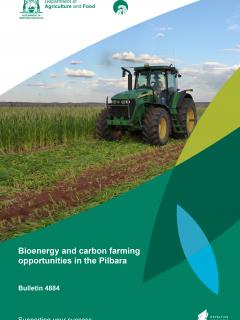A scientific review of the capacity for bioenergy developments and carbon farming in the Pilbara has found that while there are currently limited opportunities, there could be long term potential.
The Bioenergy and Carbon Farming Opportunities in the Pilbara report, prepared by the Department of Agriculture and Food, investigated the potential for the development of irrigated agriculture to generate bioenergy and carbon farming opportunities.
Department Irrigated Agriculture Executive Director John Ruprecht said the technology to create bioenergy from agricultural waste was now mature and was likely to add value to any future intensive agricultural industries.
Mr Ruprecht said there the report noted there were several risks to overcome to provide an incentive for future bioenergy investments.
“The report found successful, commercially viable long term bioenergy projects would need to be technically viable at the medium to large scale, suited to a hot climate and remote location, use locally produced feedstocks, reduce greenhouse gas emissions and other environmental impacts,” he said.
“It concludes that with these criteria in mind, the use of biomass, such as syngas, biogas or ethanol, is not favourable in the short term. The region’s remoteness is identified as a major impediment to greater participation in the carbon economy in the short term.”
The report authors also acknowledge that further, long term work is required to understand the potential yields from biomass crops grown in the Pilbara, which will help to underpin future opportunities for carbon investments.
With regards to carbon farming, the report highlights the need to develop methodologies for agricultural production to mitigate greenhouse gas emissions or remove carbon dioxide from the atmosphere (sequestration) to facilitate carbon farming opportunities.
“Current methodologies for carbon farming in the rangelands relate to reducing emissions from beef cattle production, while there are limited opportunities for sequestration activities,” Mr Ruprecht said.
“There is a need to develop methodologies for irrigated fodder production systems and mosaic irrigation systems in northern Australia to generate carbon credits, which would add value to integrated beef production systems.”
The Bioenergy and Carbon Farming Opportunities in the Pilbara report was produced by the department’s the Pilbara Hinterland Agricultural Development Initiative (PHADI).
The department works in partnership with the Pilbara Development Commission and Department of Regional Development to deliver the Royalties for Regions funded project.
“There is increasing interest in biomass production and alternative land uses in the Pilbara, such as fodder production, pivot irrigation systems and mosaic agriculture,” Mr Ruprecht said.
“This report provides valuable information for existing Pilbara landholders and potential investors about the opportunities and constraints to bioenergy developments and carbon farming in the region.”
PHADI aims to help government, industry and investors better understand the potential of irrigated agriculture in the Pilbara.
The Bioenergy and Carbon Farming Opportunities in the Pilbara report is available for free here.

Media contacts: Jodie Thomson/Megan Broad, media liaison
+61 (0)8 9368 3937
